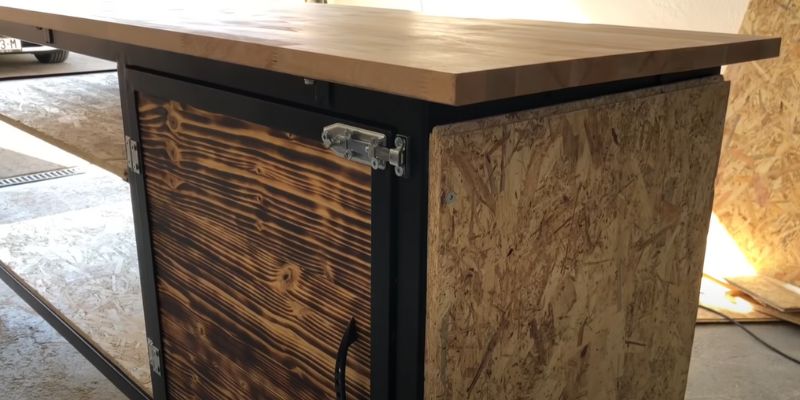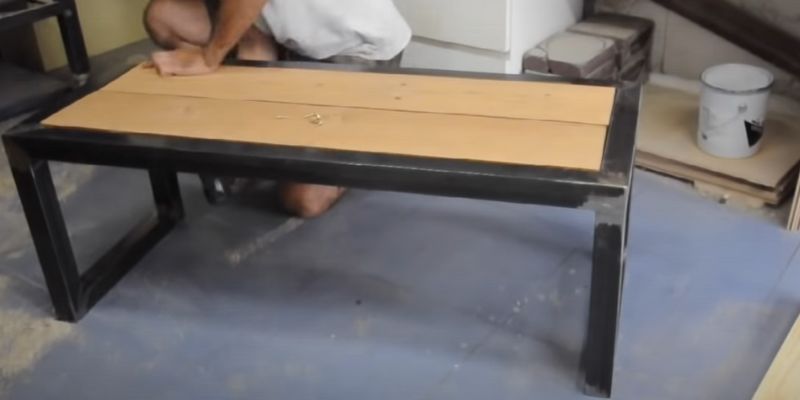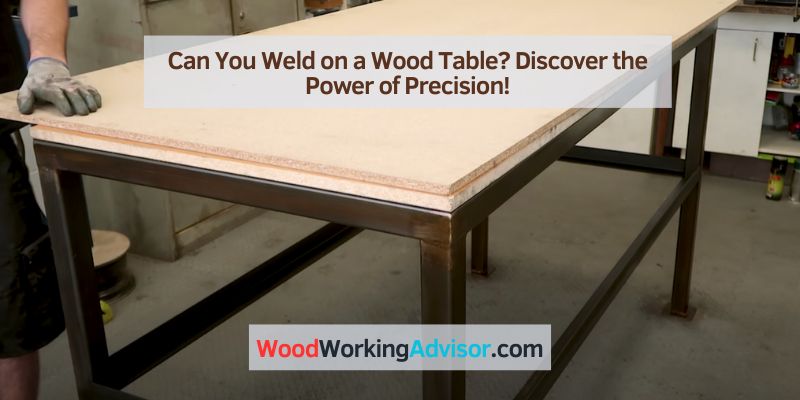No, you cannot weld on a wood table. It is unsafe and can lead to damage or fire.
Welding should only be done on proper metal work surfaces. Welding is a skilled trade that joins pieces of metal together using heat and pressure. It is commonly performed on metal tables specifically designed for this purpose. However, some individuals may wonder if it is possible to weld on a wood table.
In short, the answer is no. Welding on a wood table is not recommended due to safety concerns and the potential for damage. We will explore why welding on a wood table is not advisable, the safety risks involved, and alternative options for welding surfaces. So, let’s delve into the reasons why a wood table is not suitable for welding tasks.
Exploring The Limitations
Welding on a wood table poses limitations due to the nature of the materials. The heat generated during welding can damage or ignite the wood, making it unsafe and unsuitable for welding projects. It is important to use appropriate surfaces, such as metal workbenches, for welding to ensure safety and effectiveness.
Potential Damage To The Wood Table
While welding is a widely used and effective method of joining metal pieces together, it can pose certain risks and limitations when done on a wood table. One of the main concerns is the potential damage that can occur to the wood table during the welding process.
When welding, high temperatures are generated, which means that the wood table underneath the workpiece is exposed to extreme heat. This heat can cause the wood to scorch, burn, or even catch fire in some cases. Additionally, the intense heat can also cause the wood to warp or deform, compromising the structural integrity of the table.
To minimize the risk of damage to the wood table during welding, it is important to take certain precautions. One approach is to use fire-resistant materials such as a welding blanket or fire-resistant fabric to create a barrier between the welding project and the wood table. These materials can withstand high temperatures and help protect the wood from direct contact with heat.

Risk Of Fire Hazards
Another significant concern when welding on a wood table is the risk of fire hazards. As mentioned earlier, welding involves high temperatures, sparks, and flying debris, all of which can potentially ignite flammable materials like wood.
To mitigate the risk of fire, it is crucial to clear the immediate area around the wood table of any flammable materials, such as papers, fabrics, or chemicals. Additionally, having a fire extinguisher nearby and easily accessible is essential for quickly extinguishing any sparks or flames that may occur during the welding process.
It is also advisable to have proper ventilation in the workspace to prevent the accumulation of potentially flammable gases or fumes. Good ventilation helps dissipate heat and reduces the risk of fire hazards.
By understanding the limitations and risks associated with welding on a wood table, you can ensure the safety of both yourself and your workspace. Taking appropriate precautions such as using fire-resistant materials and maintaining a clear and well-ventilated area can help prevent potential damage and fire hazards while welding on a wood table.
The Power Of Precision Welding
If you’re a craftsman or DIY enthusiast who loves working with wood, you might be wondering if you can weld directly on a wood table. The answer is yes! With the right tools and techniques, precision welding on wood can open up a world of possibilities for creating unique and sturdy projects. In this article, we’ll explore the power of precision welding and how you can protect your wood table while working with heat and molten metal.
Using Clamps And Heat Shields For Protection
One of the key aspects of precision welding on a wood table is ensuring the protection of the table’s surface. Wood is highly susceptible to heat damage and burns, so it’s important to take necessary precautions. In order to protect the wood from the high temperatures associated with welding, using clamps and heat shields is essential.
Using clamps, you can secure your workpiece firmly onto the wood table, preventing any movement or potential damage caused by the intense heat and vibrations of welding. This not only ensures the safety of your project but also helps maintain the integrity of your wood table.
Additionally, heat shields act as a barrier between the welding process and the wood surface. Made from heat-resistant materials such as ceramic or flame-retardant fabric, these shields are positioned strategically to redirect and dissipate excess heat away from the wood. By doing so, they prevent scorching or charring, allowing you to weld on your wood table without compromising its structural integrity.
Choosing The Right Welding Method For Wood
When it comes to welding on a wood table, it’s important to choose the right welding method that suits the specific requirements of your project. Different welding techniques are available, each with its own strengths and limitations.
The most commonly used welding methods for wood include:
- Resistance welding: This method uses electrical resistance to generate heat, which is then used to join the wood pieces. It is suitable for smaller projects that require strong and durable connections.
- Ultrasonic welding: By applying high-frequency vibrations, ultrasonic welding creates friction and heat to bond wood pieces together. This method is ideal for delicate or intricate projects.
- Induction welding: Using electromagnetic currents, induction welding heats the wood surfaces and creates a strong bond. It is commonly used for larger projects and offers efficient and precise results.
By selecting the right welding method for your wood project, you can ensure a successful and reliable outcome, while also protecting your wood table from any potential damage.

Benefits Of Precision Welding On Wood
Precision welding on wood offers several benefits that make it a popular choice among craftsmen and artisans. Some of the key advantages include:
- Strength and durability: Welded connections provide exceptional strength, ensuring that your wood projects are sturdy and long-lasting.
- Clean aesthetics: Precision welding creates seamless joints, leaving no visible fasteners or adhesives, resulting in a clean and professional finish.
- Versatility and creativity: Whether you’re building furniture, sculptures, or decorative pieces, precision welding allows for endless design possibilities, giving you the freedom to bring your creative visions to life.
- Efficiency and time-saving: Welding can be a faster and more efficient method of joining wood pieces compared to traditional woodworking techniques, saving you valuable time and effort.
When done correctly and with the necessary precautions, precision welding on a wood table can be a game-changer for your woodworking projects. Remember to prioritize safety by using clamps and heat shields, and choose the right welding method to ensure strong, reliable, and aesthetically pleasing connections. With the power of precision welding, you can unlock new possibilities and take your woodworking skills to the next level!
Frequently Asked Questions On Can You Weld On A Wood Table
What Tables Can You Weld On?
Tables that you can weld on depend on the type of welding you are doing. Generally, you can weld on steel, stainless steel, aluminum, and cast iron tables. It’s important to ensure the table is clean and secure before starting any welding process.
Can You Weld Metal On Top Of Wood?
No, you cannot weld metal on top of wood as wood is flammable and cannot withstand the heat generated during welding.
Can You Weld Without A Metal Table?
Yes, you can weld without a metal table. However, it is essential to ensure a stable, fire-resistant work surface, such as a concrete or non-combustible table. This will prevent accidents and provide a safe and secure platform for welding operations.
What Is The Best Table Surface For Welding?
The best table surface for welding is a steel or cast iron table. Steel or cast iron surfaces provide a stable and heat-resistant work area for welding operations. These materials can withstand high temperatures and are less likely to warp or deform under the intense heat generated during the welding process.
Conclusion
It is not recommended to weld on a wood table due to the high risk of damage. Wood is a combustible material that can easily catch fire when exposed to extreme heat. Additionally, the intense heat from welding can weaken the table’s structure and cause it to warp or even collapse.
Instead, it is advisable to use a welding table made specifically for that purpose, ensuring both safety and longevity. With the right tools and precautions, you can enjoy the art of welding without compromising the integrity of your workspace.



One thought on “Can You Weld on a Wood Table? Discover the Power of Precision!”